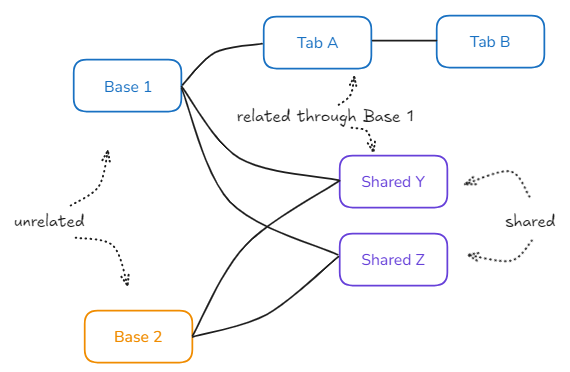In 2024, Tableau introduced multi-fact relationship modeling, a feature that elevates relationship management within the platform to a new level. This update is set to significantly improve how connections are built in Tableau, making it a valuable tool for complex data analysis. In practical scenarios, it's common to work with diverse and unrelated data sources, which can be challenging to use together. Tableau's multi-fact relationship data models are specifically designed to address these challenges, enabling seamless multi-fact analysis. The feature is called multi-fact relationship data modeling because Tableau uses relationships to build it.
How it Works
Prior to the introduction of multi-fact modeling, Tableau was limited to handling single-base table data sources, where all data had to be combined and related. Now we can integrate unrelated tables into a single data source and “stitch” the tables together based on a common table that contains the shared dimensions.
The data model can have multiple base tables, which enables us to perform a multi-fact analysis. Unlike a single-table data model, each base table in a multi-base structure retains its own context relative to the tables it shares.

A Multiple Base Table Data Model
Base tables are the foundation of a strong multi-fact relationship model and they are always present, appearing as the left-most tables in the structure. These tables act as the main source for facts or metrics, like sales, inventory, or employee data. While base tables are unrelated, they need at least one shared table to bring everything together into a single data source. Shared dimensions—like Date, Product, or Region tables—create the connections between base tables, making multi-fact analysis possible.

Key Advantages of Multi-Fact Modeling
- It is ideal for datasets with multiple, independent fact tables (e.g., sales).
- It allows analysis across multiple domains without extra data preparation.
- The granularity of each fact table is maintained.
- It reduces data duplication.
What to Watch For
- It is more challenging to design and understand, especially with relationships and joins.
- It may require multiple queries, increasing the computational load.
- Calculations across unrelated facts require precise handling to avoid errors.
Single base table models are simpler to create and maintain, offering an good solution for straightforward, single-domain analysis. However, they lack the flexibility needed for multi-domain analysis, and data duplication can result in inefficiencies.
Best Practices
Effective data modeling in Tableau relies on using logical relationships, shared dimensions, and aligning the design with analytical goals. A clear schema with well-defined relationships between base tables and shared dimensions minimizes complexity and ensures accurate aggregations without data duplication or ambiguous joins.
Avoiding Common Multi-Fact Table Mistakes
A common mistake in data modeling is selecting the wrong base table as the anchor for relationships. For instance, using a low-granularity table like yearly sales to connect high-granularity data such as daily transactions can lead to incomplete or misaligned results. Therefore it is best to choose a base table with the most detailed data.
Another issue arises when stitching fields, like a shared "Date" field, are inconsistently formatted across tables. In that case, Tableau struggles to match data points, therefore it is good practice to ensure stitching fields are standardized in both format and data type.
Cross joins are another pitfall, occurring when relationships between tables are undefined or ambiguous. These joins can explode the dataset by pairing every row from one table with every row from another. Prevent cross joins by clearly defining table relationships and testing the data model with smaller subsets.
The Future
Data modeling in Tableau is on track to become more intelligent, automated, and integrated with advanced technologies. One trend is the likely enhancement of Tableau's capabilities to handle complex multi-fact relationships, reducing the manual effort required to define and manage them. Future versions could leverage AI to identify and recommend optimal relationships between tables or suggest stitching fields.
Takeaway
Multi-fact relationship data models bring flexibility to handle evolving business needs and multi-dimensional queries, making it easier to analyze across different domains or metrics, like comparing sales with employee performance. Tableau’s future is headed toward more automation and smarter data modeling to answer sophisticated analytical questions.
